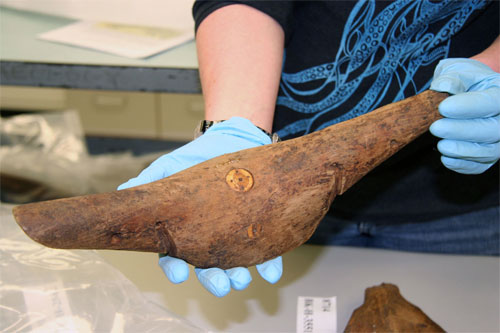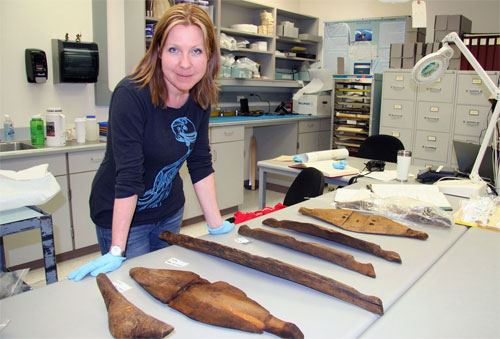
Oldest known circumpolar umiak discovered
December 14, 2012
Anchorage Museum researcher Jenya Anichenko identified the pieces during a trip to Fairbanks earlier this year to work with the Birnirk collection as part of her research on circumpolar open skin boats. One of the umiak pieces is embellished with three oval ivory inlays held in place with small ivory pins. Jenya Anichenko says they were probably decorative or significant.
The importance of the Birnirk archaeological site near Barrow was immediately recognized when it was discovered in the 1930s, but a full analysis was never published. The site was first excavated by James Ford of the United States National Museum and later by a Harvard University expedition directed by Wilbert Carter. Several boat finds were mentioned in Ford’s publication, but Anichenko wanted to learn more. “Skin boats, umiaks in particular, have always been important for the Inupiaq people,” she said. “Boats were the most technologically advanced devices in all of the indigenous arctic societies. Umiaks contain a wealth of meanings, from arctic seafaring and subsistence to social organization and spirituality. These wooden fragments are a Da Vinci code of the arctic past.” Working with these fragments is similar to forensic research, she said. “You are attempting to understand thousands of years of technical evolution on the basis of one piece of the puzzle.” By Anichenko’s count, the Birnirk’s umiak collection includes 30 wooden fragments, ranging from keel timber and bottom cross pieces to small fragments of baleen lashing. A National Science Foundation grant allowed for radiocarbon dating of three samples, one side rib and two of the umiak’s bottom crosspieces. The shortest crosspiece likely represents the cross-bottom timber nearest to the stern or stem post. The artifact is embellished with three oval ivory inlays held in place with small ivory pins. “These lack an immediate functional meaning, which implies they were used as decoration or had ritual significance,” Anichenko said.
Researcher Jenya Anichenko poses with the umiak pieces discovered in the Birnirk collection at the University of Alaska Museum of the North and dated at 1,000 years old, the oldest skin boat assembly known in the Circumpolar North.
Scott Shirar, the museum’s research archaeologist, said the return of this collection to Alaska has tremendous potential. “The level of preservation at the Birnirk site was tremendous,” he said. “Many of the organic artifacts usually not preserved in the archaeological record were preserved at this site.” Organic artifacts, such as wooden boat pieces or other tools made from fur, leather, ivory, or bone, tend to disappear over the course of a couple thousand years. The standard clues used to piece together the past usually come from more durable stone artifact types. Shirar said the wide range of artifacts and material types in this collection will support a wide variety of interests. Anichenko’s work on skin boats is just the beginning. “Now that this collection is back in Alaska and at the UA Museum of the North, researchers have the opportunity to access many untold stories just waiting to be discovered,” he said.
ON THE WEB:
Source of News:
E-mail your news &
photos to editor@sitnews.us
|
||

